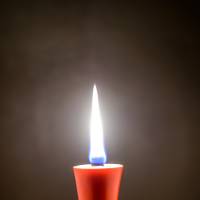Dear Alice,
My Japanese mother-in-law is very traditional and spends at lot of time maintaining the family butsudan, the cabinet-like Buddhist altar in the main room of her home. It is part of her daily routine to light candles, pray and make small offerings of food to the deceased relatives memorialized there. So when my wife and I were preparing for our annual visit, I suggested we bring nice candles from England as a gift, but my wife protested that her mother would never use a Western candle on the altar. She claims Japanese candles are "completely different" but couldn't say how. Can you explain what the heck makes a Japanese candle Japanese?
Donald, Surrey, England
Dear Donald,
I understand your confusion. There are all sorts of candles available in Japan, including plenty of imported ones, but the traditional sort that are used in Buddhist temples and on most home altars do indeed differ from Western candles in just about every way, from the wick to the wax to the way they are made.
But before I go into that, let me provide a quick explanation on nomenclature. The basic word in Japanese for "candle" is "rōsoku." But when people want to distinguish the traditional taper from the Western variety, they will tack on one of the "wa" or "yō" prefixes that indicate origin, so a warōsoku is a Japanese candle while a yōrōsoku is a Western one. To find out just how the two types differ, I paid a visit to Tanji Renshodo, a traditional candle shop in Kyoto that sells mostly to Buddhist temples.
Kiyoshi Tanji, the current patriarch of a family that has been making traditional candles for about 500 years, told me that many people mistakenly believe that the difference between Japanese and Western candles is their shape. Handing me a top-heavy candle with a wide rim and narrow base, he said, "This shape, which is called ikari-gata, is what most people think of as a Japanese candle. But there is also a straight up-and-down type, called kigake, which is exactly the same shape as a Western-style candle."
It's actually what goes into a Japanese candle that makes it different.
"Japanese candles are made entirely from vegetable matter and do not contain any animal products at all," Tanji explained. "This distinction is very important for a candle that will be used in a Buddhist temple or on an altar, because Buddhism prohibits the intentional killing of animals."
In the West, candles were once made from either beeswax or tallow, which is animal fat that has been rendered to make it more stable. Later, from about 1850, candle-making relied mostly on spermaceti, a waxy substance extracted from an organ in the head of sperm whales, or a purified animal fat called stearin. Today most candles are made of paraffin wax, which is a petroleum product.
A traditional Japanese candle, on the other hand, is always made with natural fats extracted from plants. Called mokurō, and written with the characters for "tree" and "wax," these waxes are generally made by hand and in small batches. Over the centuries, various plant sources have been used, including rice bran, but the most prized mokurō is made from the nutlike fruit of a large shrub called haze (Toxicodendron succedaneum), which is similar to a sumac tree.
Tanji showed me around his tiny workspace, pointing to various pots of haze wax from different parts of the country and explaining their differences. "Haze needs fairly warm weather, so it's cultivated in places like Kyushu, Shikoku and Wakayama Prefecture, but to be honest, there aren't very many growers any more." These days, most haze production goes into either traditional candles or bintsuke, the stiff pomade used to dress sumo wrestlers' hair.
An easy way to tell the difference between a Japanese candle and a Western one is to look at the wick. Whereas a Western-style candle relies on a braided cotton wick that looks like a string, the wick on a Japanese candle is thicker and rigid and has a conical shape. Each wick must be handmade by coiling a sheet of washi (Japanese paper) and then laboriously wrapping it with fibers pulled from the inside of a grass called igusa (Juncus effusus L. var. decipens Buchen), which, incidentally, is also used to make tatami mats. The last step is to wrap the wick with cotton fibers.
Making the rest of the candle is equally laborious. Tanji gave me a demonstration, showing me how he slips the wicks onto sticks and rubs them repeatedly with warm wax until he has a base of the right size. Later, he planes the surface to make it smooth and even, and shapes the ends with a knife. It takes years to master the many techniques that go into candle-making, and few people still learn the craft. "There used to be more than 80 traditional candle-makers in Kyoto," Tanji recalled, "but now there are only four."
While demand from temples has kept the craft alive, some consumers are willing to pay the higher price for a hand-crafted, all-natural candle. My friend Wakako, for one, is known to wax lyrical on the subject: "A Japanese candle makes less soot and is less likely to drip," she said. "And the flame is larger and brighter. It moves more, and won't blow out in a draft."
Shops specializing in Japanese candles are few and far between, but warōsoku are available online and many vendors will ship overseas. You can usually find them in Buddhist supply stores, and many gift shops, particularly in tourist destinations, carry erōsoku, which are candles painted with pretty floral designs. But if you're in Kyoto, please drop by Tanji's shop, which is a 5-minute walk from JR Kyoto Station near Higashi Honganji Temple, on the north side of Shichijo Street at Karasuma Nishi-iru. If you're lucky, he'll be making candles when you arrive; visitors are welcome to watch.




